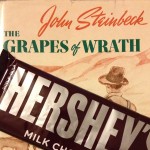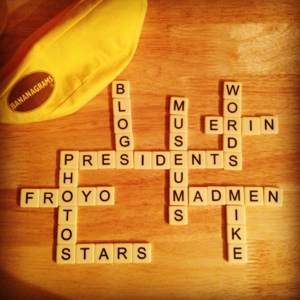I have no food allergies or intolerances that I know of, but I still cook a gluten-free, lactose-free, butter-and-margarine-free, egg-free, chocolate-free, nut-free Thanksgiving dinner anyway. The people I share Thanksgiving with have a combination of food allergies and intolerances, and thus Thanksgiving, Christmas, Easter and any other holiday are a labor of love to make sure we can celebrate with traditional foods but without anyone getting sick.
When I mention this to people, usually I get one of two reactions: either “Wow, that’s a lot of trouble” or “…and taste-free too, right?”
It is a little bit of trouble, but isn’t Thanksgiving dinner in general? And I promise you, there is nothing taste-free about the dinner I make. I think the fat-free craze of the 90s left people with the lingering prejudice that anything that has -free as a suffix is automatically unpalatable. This was the fifth Thanksgiving I’ve cooked like this, and I’ve worked hard to find recipes that work for everyone and still taste like holiday memories from growing up.
So mostly for my own organization but also for your benefit, here is the menu list and the recipes I use on Thanksgiving. If you use any of these, note that your best friends in this process will be cornstarch, ground flaxseed, canola oil, all-vegetable shortening, and anything from Bob’s Red Mill gluten-free line.
Turkey:
Find the process/recipe at SeriousEats. This bad boy does not need to be basted in butter to be delicious, I promise. Last year I heard a piece on NPR about spatchcocking your turkey, and if you ever cursed your bird for taking so long to roast, I recommend this process which involves cutting the spine out of your turkey and splaying the turkey out on a baking pan. It’ll be done in an hour and a half, you’ll be happier because you don’t have to get up at 6 a.m. to start basting, AND you don’t have to have the argument about why there’s no stuffing from inside the bird because there is no inside to the bird. I use the spine and neck to make broth as the recipe recommends (except I use Better than Bouillon vegetable base to make the extra broth to go in with my turkey extras, as it has no wheat in it), which brings me to…
Gravy:
Find the recipe at Argo cornstarch. Gluten-free gravy is much easier than I initially thought, thanks to cornstarch. I take my spine broth and follow the recipe on the Argo canister. (If you saw the movie Argo, now is a good time to make the signature joke from the movie. If you didn’t, you can just move on with the rest of us.)
Stuffing:
Find the recipe at Real Simple. Stuffing for a gluten-free audience is not as unattainable as it would seem. I make up a loaf of Bob’s Red Mill Homemade Wonderful Bread on the Monday or Tuesday before Thanksgiving, using flaxseed meal instead of the egg and lactose-free cow’s milk for the milk. The stuffing itself comes together pretty easily, sauteing the veggies and apples in canola oil rather than butter, making Better than Bouillon vegetable base rather than chicken stock, and using flaxseed meal in place of an egg again. And, of course, leaving out the nuts for those adverse to nuts.
Mashed potatoes:
Find the recipe from Betty Crocker, in case you’re like me and always forget how long potatoes need to simmer. I grew up eating potatoes that had been mashed with cream and butter, so out of everything on this list, this was my biggest mental adjustment, if you’ll believe it. Rather than using lactose-free milk, which I have in the past but always felt it came out thin, I mashed the potatoes with turkey stock reserved from the broth I made for the gravy. (I have done this with vegetable base when I’m expecting vegetarians to dinner. I don’t go so far as to make a tofurkey or anything but I try to be accomodating.) It gets a rich taste, it’s lighter, and I can still add all the butter I want to my serving at the table.
Sweet potatoes:
Find the recipe at Crockpot365. I’m not sure anyone in my crowd actually likes sweet potatoes, but I had some from our co-op basket this year and decided to make them, if only for some color. The only substitution I made was to spray the crock with cooking spray rather than grease it with butter. I also love that this recipe can be done in the crock-pot and not take up precious oven real estate. (I left off the marshmallows — I know, sacrilege! — but that’s a personal choice.)
Green bean casserole:
This is a mashup of three recipes, one from Food.com, one from 100 Days of Real Food, and one from Crockpot 365. I follow the vegan recipe for making the soup base, except with lactose-free milk instead of soy, then I pick up with the real food recipe (including using fresh green beans, which I prepped the night before so I wasn’t snapping green beans like a mad woman on Thursday), and then I follow the Crockpot 365 directions for cooking the whole thing in the crock-pot (your two-quart one you usually reserve for making Velveeta dips will do nicely). I used gluten-free baking mix to coat and fry onions rather than using French’s (which, yes, have wheat in them) for the topping and popped the whole thing in the oven to crisp up and congeal a little before serving.
Carrots:
Find the recipe at BBC Good Food. Again, I’m not sure how much anyone likes cooked carrots but I like them for color. I liked that there was another vegetarian-friendly dish on the table. Also, the Anglophile in me likes that this one comes from the BBC.
Cranberries:
Find the recipe at Real Simple. Seriously, who would eat cranberries wiggled out of a can when you could eat cranberry bourbon compote? They’re beautiful, they’re easy, they smell amazing while they cook, they’re a piece of the meal that isn’t harmed by doing on Monday or Tuesday even, they only have four ingredients (all of which you can control the portions), and they make you look like a real fancy pants (in the best way possible). You probably spend less time prepping these than you would wrestling the jellied cranberries out of the can. I don’t even like cranberries and I love having this on my table.
Jell-O:
Because I’m secretly five years old at heart, there is always raspberry Jell-O on the Thanksgiving table. My mom and grandma always made Jell-O for me and my brother in a cranberry-ish color because neither of us liked actual cranberries. I don’t put Cool Whip on the Jell-O like they did (there is dairy in Cool Whip now, which I don’t think used to be the case) but it still makes me happy.
Breads:
I didn’t get as far as making bread for the table this year, but I had a package of of Bob’s Red Mill Gluten-Free Cornbread Mix I was intending to make. This stuff is really good. I have also made gluten-free cornbread from scratch, but it never turns out as nicely as I want it to, probably because I don’t have a cast-iron skillet to bake it in.
Pumpkin Pie:
Find the base recipe from Very Best Baking. I don’t like pumpkin pie as a general rule, but I know that makes me something of an oddity. So of all of the labors of love listed above, this one is the one that comes the most from my heart because I really and truly am making it for everyone else. In the regular pumpkin pie recipe (using canned pumpkin and not premade pumpkin pie filling), substitute 1 tablespoon of cornstarch for each egg, and 1.5 cups of lactose-free milk for the canned milk. It won’t set up quite as nicely as the recipe on the Libby’s can, but it tastes the same. The pie crust came off of the Bob’s Red Mill Gluten-Free Biscuit and Baking Mix, using shortening instead of butter. I had problems getting the dough to roll out nicely, so I pressed it into a muffin tin and made everyone their own little pie-lettes. You’ll have dough leftover to make cinnamon twists if you’re feeling inspired, but the filling will just fill the twelve little crusts.
And there you have it. I don’t think it’s harder than any other Thanksgiving dinner you make at home. I promise you: if I can do this, you can do this. While I’m not going to pretend it’s healthy by any means, it’s better for you because with the exception of the Jell-O and the Bob’s Red Mill mixes, you know exactly what’s going into each step. And I feel better knowing that the only way anyone at my table is going to get sick from dinner is if they overeat.

